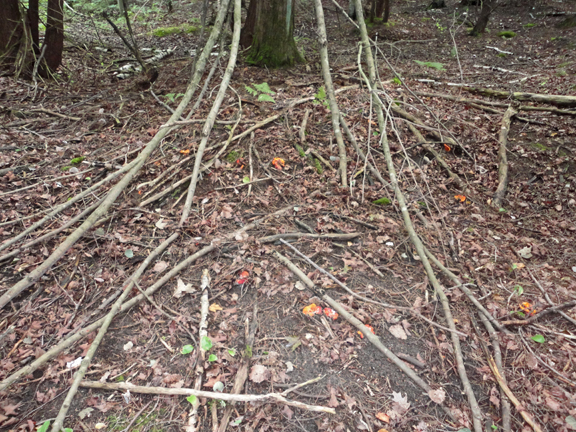Hypomyces lactifluorum, AKA the lobster mushroom, is one of the more common choice edible wild mushrooms in the Southern Ontario forests I visit. I’ve written about lobsters a number of times before. They’re unusual in that the mushrooms we pick as lobster mushrooms are in fact host mushrooms that have been attacked by another fungus. The attacking fungus contorts the shape of the host and coats it with a red crust. It also makes the whole item delicious.
Some people will not eat lobsters because they cannot identify the contorted host and they are concerned that a poisonous mushroom has been attacked by the known to be quite edible Hypomyces. Many articles suggest that the hosts for this parasite are are always Russula brevipes or Lactarius piperatus, two mushrooms that are not palatable prior to attacked by the parasite fungus. Can the parasite attack other possibly poisonous hosts? As Tom Volk suggests on his website, lobster mushrooms have been eaten for hundreds of years without known problems. In fact, I’ve seen dried lobsters in some grocery stores. I’ve been eating them with some regularity for a few years now without any issue.
 This is how lobster mushrooms look in the forest. They tend to be lumpy and contorted and sometimes partially covered or filled with material from the forest floor.
This is how lobster mushrooms look in the forest. They tend to be lumpy and contorted and sometimes partially covered or filled with material from the forest floor.
 There are at least a dozen lobster mushrooms visible in this shot, which was taken in a hemlock forest. You can see a couple of the specimens are a rosy red while others are more orange. Orange, red-orange or washed out red-orange are all good colours. By the time they get rosy in colour, they are almost always past their expiry date. When you see them in the forest, look for specimens that are firm. Don’t worry if there are a couple holes in the mushroom.
There are at least a dozen lobster mushrooms visible in this shot, which was taken in a hemlock forest. You can see a couple of the specimens are a rosy red while others are more orange. Orange, red-orange or washed out red-orange are all good colours. By the time they get rosy in colour, they are almost always past their expiry date. When you see them in the forest, look for specimens that are firm. Don’t worry if there are a couple holes in the mushroom.
The only negative to lobster mushrooms is that they are a pain to clean. I start by cutting away anything that looks soft or pulpy or too red. Then clean the mushrooms under cold running water. These are dense mushrooms and will not be compromised by being washed in water. You might find a toothbrush is helpful in getting the forest floor off your mushrooms. Then slice your mushrooms up in slices that are about an eighth inch thick. Once you’ve done that, cut away anything that is not firm, white or orange-red-organge. If I don’t like the looks of it, I cut it away. The cleaned, sliced up mushrooms keep well in the refrigerator for a few days.
When you cook Hypomyces lactifluorum, they retain their firm texture and can even add a bit of crunch. Of course I know you will not be silly enough to collect, cook and eat wild mushrooms. If you decide to do so, remember that it is against my advice. Do as I say and not as I do.

There are loads of edible mushrooms in southern Ontario, let me tell you what i found, the Boletus Edulis, Chicken of the Woods, Hen of the Woods, Giant Puffballs, the Chicken Mushroom and brown and red caps ( Boletus Family). Most I found right here in Toronto and some in the Dufferin County area–oh yes also the honey mushroom.
Good for you Jack. Those are excellent finds.
Odd looking rascals.
But tasty